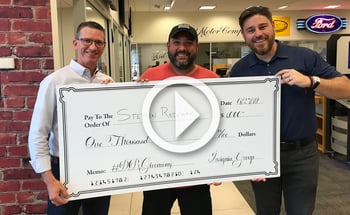
The check engine light in a car is a warning sign of an underlying problem. Objections are no different. They’re a sign to point you to the actual problem.
Every day, car salesmen and women do mental gymnastics to get a car sold. At first, it can be strenuous and stressful—so practicing overcoming objections will make you more skilled. Before long, you'll be flipping over that balance beam with grace.
Selling accessories at the point of sale can also bring objections. Learning to bend without breaking in this arena offers enormous payoff. Within 90 days of purchase, 80% of your customers will accessorize their car. You can be sure that they’re going to buy accessories somewhere.
Learn to overcome these common objections and get that cash back in your pocket.
"Yes, I Want Something, But..."
Sometimes the customer just wants to be done, so they make an excuse.
First, ensure that you're presenting accessories at the right time. The right time is after the car sale and before F&I. Next, acknowledge the objection. Nobody wants to be ignored or interrupted.
If your customer says they like something then adds: “I’ll come back to this later,” “I need to talk with my spouse,” or “I wasn’t planning to spend the money right now”; present them with the warranty and financing benefits of buying now!
Try responding “Sure, it’s okay to come back and purchase accessories later. I do want to make you aware of the warranty protection that you will miss out on though.”
Purchasing accessories at the point of sale will afford the customer the same warranty as the new vehicle; typically three years. If they buy accessories later, the warranty for the accessory applies, which generally is only one year.
Make sure your customer understands that buying accessories now will allow them to roll them in with their monthly car payment with a much lower interest rate than a credit card.
After you explain those benefits to your customer, try to close the sale again.
If all of these fail, there’s one more thing you can try. Is your customer possibly overwhelmed, hungry, or tired? Make sure they’ve got a quiet, comfortable environment to shop accessories. Leave them alone while you go get them a drink and a snack. Hanger is a real thing.
"No, I Don't Want Anything"
Never accept the first no. In fact, act surprised.
Typically, 9 out of 10 customers will accessorize their vehicle, so it should genuinely surprise you when a person is disinterested.
Try saying “Okay, I understand that you don’t want anything. I offered these because most of my clients find something here. Earlier you mentioned that a clean car is important, so I wanted to make sure you had the opportunity to upgrade to leather. It’s so much easier to keep clean!”.
Tailored responses to an objection allow you to return to the presentation by referencing something the customer said earlier. When you use their own words, you may get a new objection. That’s fine too. It means you’re getting closer to uncovering the true objection.
Remember that numbers show this client is the exception, not the rule.
The Shut Down Customer
The shutdown customer won’t allow you to talk about, or present accessories. It’s a hard pass from the very beginning.
Use the manufacturer’s response to the objection that comes up during your pitch.
Try saying “I understand that you’re not interested. [Insert your manufacturer’s name] has asked us to make you aware of ways to personalize and protect your vehicle, so this just part of my job”!
Their response may give you more to work with. At this stage, they haven’t given you an objection to overcome so you will have to keep trying to get one.
Remind them of things they said to you during the needs assessment, and use those to point back to accessories they might want.
At the end of the day, following these steps to overcome an objection are a proven method to close the sale. Once you’ve done that, you can walk away confidently regardless of whether the custom said yes or no. You’ve done your job!



